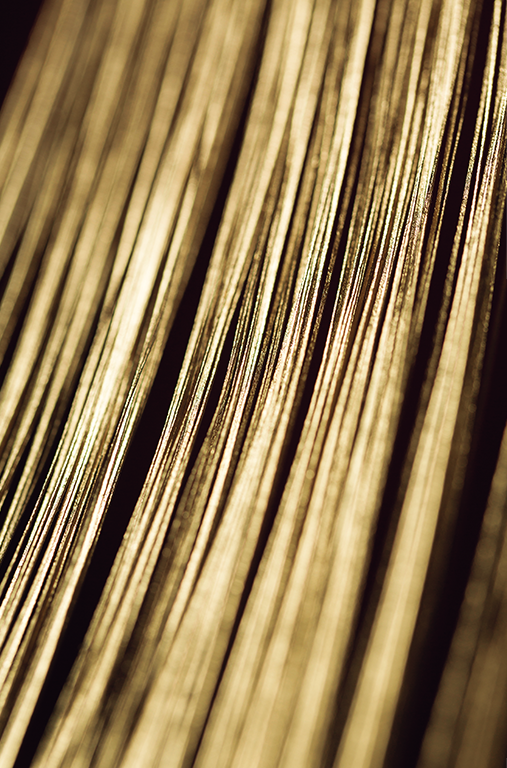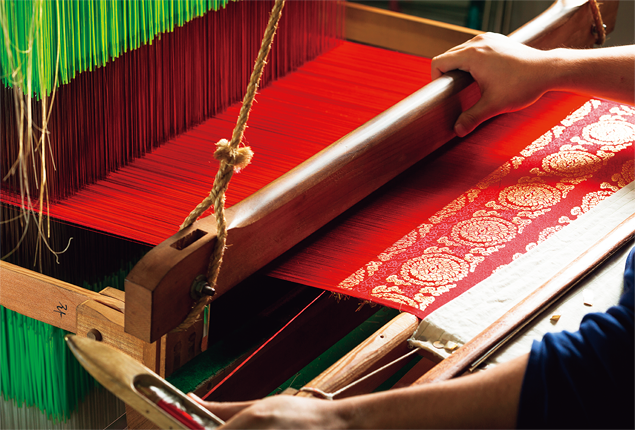In the mid-18th century, the Joseon Dynasty king banned the production of gold-brocaded silk fabrics in order tocurtail extravagance. Members of the royal family and the nobility, who prized the sumptuous fabric for their court andceremonial garments, imported the material from Qing Dynasty China. Over time, the elaborate, millennia-old brocadeweaving skills were about to disappear into oblivion. But Professor Sim Yeon-ok at Korea National University of CulturalHeritage has revived the forgotten weaving technology through painstaking research and experimentation.
Professor Sim Yeon-ok of the Department of TraditionalArts and Crafts at Korea National Universityof Cultural Heritage demonstrates patterned silkweaving on the 16th century loom replica that shehas re-d.
To what extent do we know about the past? When I read anarticle that reported on how the secret to the ancient methodof making gold thread had been finally solved, I had to thinkabout the depth of my knowledge about ancient fabrics. Were wetalking about the golden patterns on traditional clothing even withoutknowing how the gold thread had been made? How much do weknow about our heritage from the past, including the so-called culturalproperty?
Unraveling Ancient Secrets
“Excavated clothing artifacts from the Joseon Dynasty have beenrestored in large quantities. We Koreans are very good at restoringthe styles of period clothing and replicating them faithfully, downto the exact needlework of the time. The problem is often with thematerial. Re-creating the clothes of Baekje, Goryeo and Joseonwith fabrics bought at Dongdaemun Market— that’s just a half-baked restoration,”laments Professor Sim Yeon-ok at KoreaNational University of Cultural Heritage inBuyeo, South Chungcheong Province. Hervoice is firm and assertive, a noticeablechange from her soft and easy-going toneof just a moment ago when talking abouther daily life.

Gold thread is made painstakingly in the old way bygluing polished gold leaf onto a sheet of mulberrypaper and cutting it into fine strips.
The first step in the restoration of anancient garment should be to reproducethe material, and only then can its form bediscussed. But in general, this has not beenthe case in Korea. Sim explained: “As forsilk woven with golden patterns, the traditionof hand-loomed pattern weaving wasdiscontinued long ago. Since King Yeongjoof the late Joseon era issued a royal decreein 1773 that prohibited the production ofgold-woven fabrics, the craft has becomeextinct. Furthermore, automation sweptevery aspect of production in the 20th century.Now, all that remains are automatedpower looms and all that matters is speed— how much they can weave per minute.These machines can only weave fabricsthat are flat with no sense of dimension.”
Sim re-d the patterning loom bystudying old and new literature and materials.She analyzed the illustration of the loom contained in the “SixteenTreatises on Rural Economy (Imwon gyeongje ji),” an encyclopedicbook on practical technologies written by Seo Yu-gu in theearly 19th century during the Joseon Dynasty, along with examiningsimilar types of looms still extant in China. The outcome wasan intricate wooden loom, measuring 6 meters long and 4 metershigh. Then, she turned her attention to the gold patterns on fabricartifacts, which had given splendor to the wardrobes of royaltyand the nobility in the distant past. She began by studying the goldthread. First, she had to figure out how the gold thread had beenmade. Together with her students, she reviewed 111 referencesources from Korea and abroad, as well as 68 ancient artifacts fromKorea, China and Japan. The studies led to surprising discoveries.First and foremost, she found that the gold threads in the relicswere not solid gold fibers, but thin strips cut from sheets of polishedgold leaf glued to mulberry paper.
Sim recalled: “We analyzed the components of a gold threadfrom the Goryeo Dynasty [918–1392] and found that the thread containedtraces of traditional Korean paper made from paper mulberry[Broussonetia kazinoki], the same kind used for the Buddhistscriptures that were excavated together with it.
It was thusconcluded that Koreans in the past madetheir own gold threads and used them inweaving fabrics.In Central and WesternAsia, leather was used instead of paper;leather sheets could be pounded thinnerthan paper. In places where leather was notreadily available, animal intestines wereused. Japan and China did use paper, madefrom different plants — Gampi [Wikstroemiatrichotoma] in Japan, and mulberry[Morus alba] and bamboo in China. Whathad been unknown until that point wasfinally clarified.”
She did not stop at discovering themethod and material, but went on to makeactual gold threads and weave fabricsusing her re-d loom. The process ofreproduction was like trying to find one’sway in an unfamiliar landscape. She hadto determine optimal qualities of the mulberrypaper for making the threads, andrepeatedly experimented to find the glue’sproper consistency. She also had to figureout exactly how a sheet of gold leaf and asheet of paper could be perfectly joined.
The procedure that was most difficult toperform was shredding. She had to put allher heart into the task of cutting the goldleaf-coated mulberry paper into 0.3mmstrips. The cutter blade had to be repeatedly sharpened, as washer acuity and concentration, in order to properly execute the intricatework. Weaving patterns on a loom using the hard-won threads,she also had to fight off any stray thoughts because the strandssnapped too easily whenever she was distracted. Finally, she succeededin reproducing three kinds of fabrics with gold-woven patterns — one from Goryeo and two from Joseon — reviving a losttechnology in the ancient craft of handloom weaving.
She had to put all her heart into the task of cuttingthe gold leaf-coated mulberry paper into 0.3mmstrips. The cutter blade had to be repeatedlysharpened, as was her acuity and concentration,in order to properly execute the intricate work.
Moments of Discovery
Sim humbly plays down her role by saying that it was “just asmall accomplishment in the restoration of traditional fabrics.”Then, as the author of “Five Thousand Years of Korean Textiles,” anillustrated catalogue of Korea’s textile history that focuses on technologicalaspects, she went on to discuss restoration of fabrics in abroader sense. Fabric restoration, as she puts it, is like solving a jigsawpuzzle in which you have to complete the entire picture workingwith just a few pieces of evidence. Studying fabrics that had beenburied underground for a longtime, sustaining severe damage,means investigating smallscraps of torn cloth. To restoreancient fabric-making technology,Sim analyzed every singleingredient of the scraps andreassembled the broken brocadepatterns into their originalform based on historicalreferences. Thus she d aproper fabric sample.

Gold thread patternsare woven into silkfabric using the patterningloom.
She went through a similarprocess with the cloth fragmentrecovered from the SakyamuniPagoda at BulguksaTemple, built in the 8th century,when it was dismantledfor maintenance work. “It wasa severely damaged piece ofcloth with its patterns no longervisible and fibers torn apartinto messy bits and pieces. Idecided to count all the interlacedstrands one by one — it had tens of thousands of strands andit took three months to count them all. Finally, I could decipher thepattern and reproduce the actual shape [of the material], which Ifigured to have been a draw cloth bag in five colors made withexcellent craftsmanship. It was a significant undertaking, especiallybecause there had been no fabric specimen from the Unified Sillaperiod,” she explained.
Sim went on to mention several other moments of discovery. Sherecalled a time when a golden spot that had looked like a piece ofgold leaf at first glance was later determined to be a gold thread,based on the trace of a papery element she found.
Most memorably,by demonstrating that an unearthed piece of old cloth wovenwith uniquely spun strands was a cotton scrap from the BaekjeKingdom (18 B.C.–A.D. 660), she proved that cotton had been introducedto Korea not in the 14th century, as was then believed, buthad already been cultivated in Korea some 700 years earlier. Simrecalled still another instance of discovery: “I came across a smallpiece of cloth from what I assumed to have been a women’s trinket,but then I noticed that it was a patchwork of over 15 kinds ofcloth interwoven with gold thread applied with an array of handicraftskills, including gold leaf imprinting and embroidery. It was sobeautiful that I couldn’t take my eyes off it.”
Her accounts of fabrics are elaborate and resourceful: “Silk isextremely good at mixing with other materials, and knows howto reveal its luxuriance. Silk is excellent at transformation. On theother hand, ramie is so pure and delicate that you shouldn’t tamperwith it. Cotton seems to beplain, pure and naïve, but it isthe fabric that can give you themost trouble. Spun from cottonfiber, the yarns are very easilybroken before they are woveninto a fabric.”
Fabrics in Modern Life
Sim said there are over 500kinds of traditional fabrics currentlyproduced in Korea. However,most of us don’t see ortouch them in our daily liveseven though we begin and endour days covered in fabrics. Shecriticized the “all-season polyesterhanbok,” and elaboratedon her view of traditional Koreandress losing its aestheticand functional diversity: “Theparticular dress has ruined ourtraditional textiles. In the olddays, hanbok was made from avariety of fabrics, by season. A certain fabric for today, and anotherfor tomorrow when it grows a little colder. People wore ramie andChinese fine silk [eunjosa] in mid-summer, raw silk [saenggosa]when it got cooler, silk organza [sukgosa] after Chuseok [autumnharvest holiday], and then silk gauze. When it got cold, people woresilk gauze padded with cotton, followed by solid cotton for all seasons,and then twill damask [neung]. In the early modern period,they also used brocade.”
In the days before indoor heating, clothing was critical to help thebody cope with seasonal changes. Naturally, a vast array of fabricswas needed for making seasonal garments. But today’s clothing,with a focus more on design than on fabrics, could do well withoutso much variety.
Sim asserts that the exquisite hand-weaving skills of our ancestors are also useful in this modern era, and hopes that the aestheticsand charm of each and every fabric can be rediscoveredto enrich our everyday lives. She believes traditional textiles are atreasure trove of ideas for contemporary arts.
Gold-brocaded fabricsmake elegant andsplendid garments forceremonial wear.
Threads of Connection: Teacher and Student
How have Sim’s thoughts and ideas been transmitted to her students?“Fabrics help make me be myself. Talking about our basicneeds, we Koreans say ‘clothing, food and shelter.’ I often wonderwhy we put clothing ahead of the others although we know thatfood and shelter are just as critical for survival. I think it’s becauseclothes, or fabrics for that matter, help us to be our own selves,”said Keum Da-woon, one of Sim’s students, when asked what textilesmeant to him.
Professor Sim, who had been making tea, stopped to listen. Theteacher had stressed that all the projects at the Research Institutefor Traditional Textile Restoration at the school get started, progress,and are completed thanks to her students. What is it, I askedthe student, about the professor he wanted most to emulate. Hisreply seemed to transcend the question: “I don’t think it’s my wayto like my teacher because of her merits or achievements. As therelationship between a parent and a child isa given, not a choice, I feel that our beingsare connected. It’s also true of my studies.I feel most comfortable and natural doingmy studies, just like I do in these clothesthat I’m wearing.”
Silently, Sim gazed at the tranquil faceof her thoughtful student. Whenever talking about her accomplishments,she would mention her own teacher, Min Gil-ja, who laid thegroundwork for research on traditional Korean textiles during herlifetime. Seemingly lost in contemplation, she may have been thinkingof her own teacher’s words: “It’s most important to first live asa human being. You come first, and then your academic pursuits.”Or, she may have thought about the last moments with her teacherwho had bequeathed to her an extensive collection of her belovedbooks, saying, “I appreciated it when you didn’t covet these books,trying to learn one thing at a time on your own.”
Without asking Sim what she was thinking, I left the place ladenwith stories of teachers and students, where the theme of fabricsand humans are sure to blossom into more stories of life from theancient past.
Kang Shin-jaeFreelance Writer
Ahn Hong-beomPhotographer